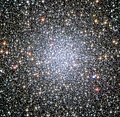File:Hubble Catches Stellar Exodus in Action (17644845341).jpg

Pradinė rinkmena (3 359 × 3 288 taškų, rinkmenos dydis: 14,85 MiB, MIME tipas: image/jpeg)
Captions
Captions
Aprašymas[keisti]
| AprašymasHubble Catches Stellar Exodus in Action (17644845341).jpg |
Using NASA’s Hubble Space Telescope, astronomers have captured for the first time snapshots of fledging white dwarf stars beginning their slow-paced, 40-million-year migration from the crowded center of an ancient star cluster to the less populated suburbs. White dwarfs are the burned-out relics of stars that rapidly lose mass, cool down and shut off their nuclear furnaces. As these glowing carcasses age and shed weight, their orbits begin to expand outward from the star cluster’s packed downtown. This migration is caused by a gravitational tussle among stars inside the cluster. Globular star clusters sort out stars according to their mass, governed by a gravitational billiard ball game where lower mass stars rob momentum from more massive stars. The result is that heavier stars slow down and sink to the cluster's core, while lighter stars pick up speed and move across the cluster to the edge. This process is known as "mass segregation." Until these Hubble observations, astronomers had never definitively seen the dynamical conveyor belt in action. Astronomers used Hubble to watch the white-dwarf exodus in the globular star cluster 47 Tucanae, a dense swarm of hundreds of thousands of stars in our Milky Way galaxy. The cluster resides 16,700 light-years away in the southern constellation Tucana. Read more: www.nasa.gov/feature/goddard/hubble-catches-stellar-exodu... Credits: NASA, ESA, and H. Richer and J. Heyl (University of British Columbia, Vancouver, Canada); acknowledgement: J. Mack (STScI) and G. Piotto (University of Padova, Italy) NASA Goddard Space Flight Center enables NASA’s mission through four scientific endeavors: Earth Science, Heliophysics, Solar System Exploration, and Astrophysics. Goddard plays a leading role in NASA’s accomplishments by contributing compelling scientific knowledge to advance the Agency’s mission. Follow us on Twitter Like us on Facebook Find us on Instagram |
| Data | |
| Šaltinis | Hubble Catches Stellar Exodus in Action |
| Autorius | NASA Goddard Space Flight Center from Greenbelt, MD, USA |
Licencija[keisti]
- Jūs galite:
- dalintis – kopijuoti, platinti bei persiųsti šį darbą
- pri(si)taikyti – adaptuoti darbą
- Su šiomis sąlygomis:
- autoriaus nurodymas – Turite pateikti atitinkamą kreditą, pateikti nuorodą į licenciją ir nurodyti, ar buvo atlikti pakeitimai. Tai galite padaryti bet kokiu būdu, bet ne taip, kad licencijos išdavėjas patvirtintų jus ar jūsų naudojimą.
| This image was originally posted to Flickr by NASA Goddard Photo and Video at https://flickr.com/photos/24662369@N07/17644845341. It was reviewed on 2016 m. rugsėjo 17 d. by FlickreviewR and was confirmed to be licensed under the terms of the cc-by-2.0. |
2016 m. rugsėjo 17 d.
| Public domainPublic domainfalsefalse |
| Šis failas licencijuojamas viešajam naudojimui, nes jis buvo sukurtas NASA. NASA autorinių teisių taisyklės nurodo, kad „NASA medžiaga nėra saugoma autorinių teisių, išskyrus pažymėtą“ (NASA autorių teisių taisylės arba JPL paveikslėlių naudojimo tvarka). |  | |
 |
Įspėjimai:
|
Rinkmenos istorija
Paspauskite ant datos/laiko, kad pamatytumėte rinkmeną tokią, kokia ji buvo tuo metu.
| Data/Laikas | Miniatiūra | Matmenys | Naudotojas | Paaiškinimas | |
|---|---|---|---|---|---|
| dabartinis | 20:14, 17 rugsėjo 2016 |  | 3 359 × 3 288 (14,85 MiB) | Vanished Account Byeznhpyxeuztibuo (aptarimas | indėlis) | Transferred from Flickr via Flickr2Commons |
Jūs negalite perrašyti šios rinkmenos.
Rinkmenos naudojimas
Šis puslapis naudoja šią rinkmeną:
- File:Globular cluster 47 Tucanae (18406015771).jpg (failo peradresavimas)
Visuotinis rinkmenos naudojimas
Ši rinkmena naudojama šiose viki svetainėse:
- Naudojama lt.wikipedia.org
Metaduomenys
Šioje rinkmenoje yra papildomos informacijos, tikriausiai pridėtos skaitmeninės kameros ar skaitytuvo, naudoto jai sukurti ar perkelti į skaitmeninį formatą. Jei rinkmena buvo pakeista iš pradinės versijos, kai kurios detalės gali nepilnai atspindėti naują rinkmeną.
| Plotis | 3 359 px |
|---|---|
| Aukštis | 3 288 px |
| Bitai komponente |
|
| Suspaudimo tipas | LZW |
| Taškų struktūra | RGB |
| Pasukimas | Standartinis |
| Komponentų skaičius | 3 |
| Horizontali raiška | 72 taškai colyje |
| Vertikali raiška | 72 taškai colyje |
| Duomenų išdėstymas | stambusis formatas |
| Naudota programinė įranga | Adobe Photoshop CS6 (Macintosh) |
| Rinkmenos keitimo data ir laikas | 16:12, 4 gegužės 2015 |
| Spalvų pristatymas | sRGB |
| Datos ir laiko pervedimas į skaitmeninį formatą | 23:27, 13 spalio 2014 |
| Paskutinį kartą metadata duomenys keisti | 12:12, 4 gegužės 2015 |
| Unikalus ID orginalus dokumentas | xmp.did:18e32bb0-fbcb-2e44-803a-261c2faeb389 |